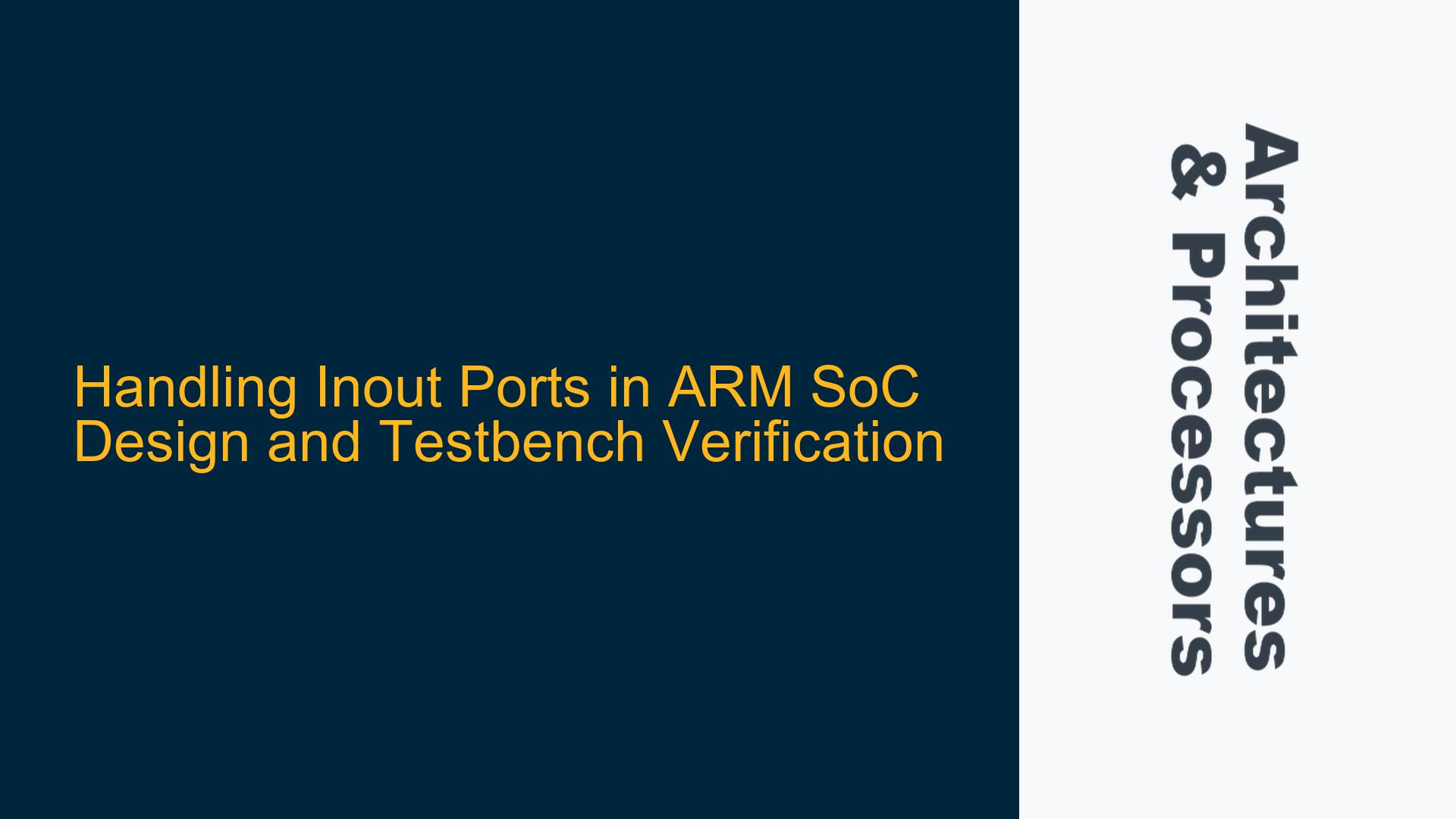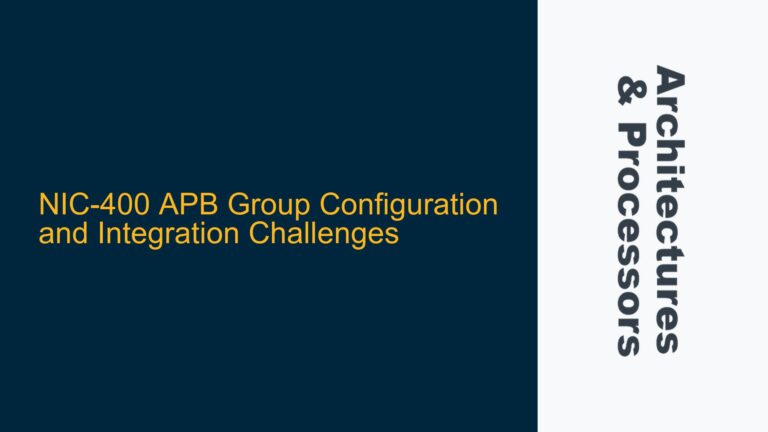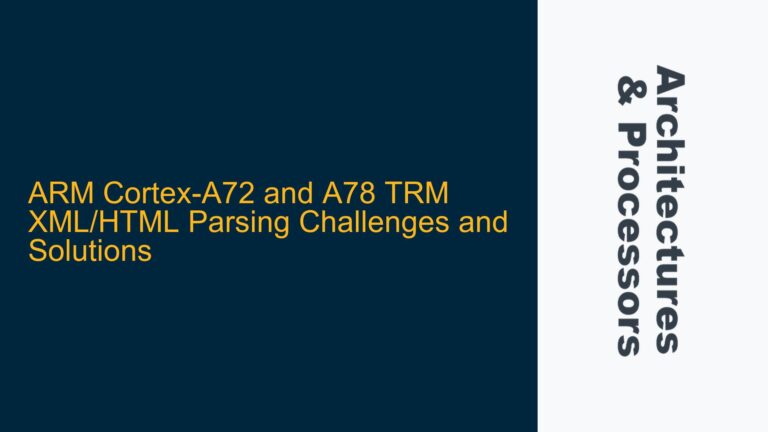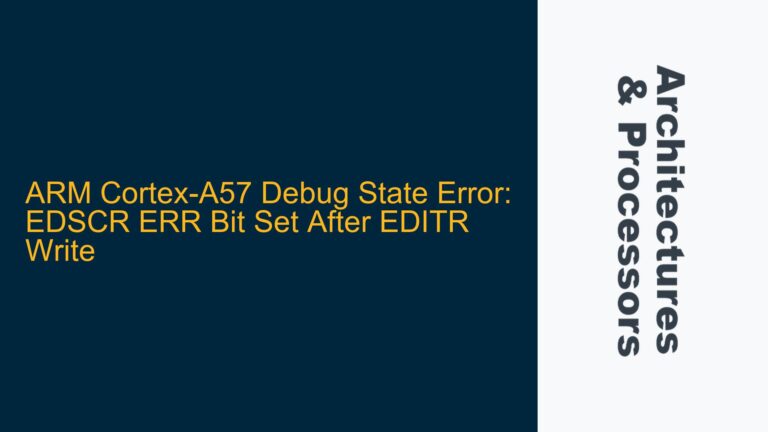Multiplexing a Single Databus into Separate Read/Write Buses Using Inout Ports
In ARM-based SoC designs, efficient data transfer mechanisms are critical for performance and resource optimization. A common scenario involves multiplexing a single bidirectional databus into separate read and write buses to streamline data flow. This is often achieved using inout ports in the hardware description language (HDL). However, implementing and verifying such designs can be challenging, especially when dealing with simulation mismatches and testbench complexities.
The core issue arises when a single bidirectional databus, typically used for both reading and writing, is split into two unidirectional buses—one for reading and one for writing—using control signals. While the concept is straightforward, the practical implementation often leads to simulation errors, timing mismatches, and difficulties in testbench development. These problems stem from the inherent complexities of handling bidirectional signals, ensuring proper signal contention resolution, and accurately modeling the behavior of inout ports in simulation environments.
The challenges are further compounded when writing testbenches for designs with inout ports. Assigning values to and reading from the same port requires careful handling of signal drivers, high-impedance states (Z), and proper timing to avoid conflicts. This post delves into the technical intricacies of addressing these issues, providing a detailed analysis of the root causes and actionable solutions.
Control Signal Timing and Contention in Bidirectional Bus Multiplexing
The primary cause of simulation mismatches in designs involving inout ports and bidirectional bus multiplexing is improper handling of control signal timing and signal contention. When a single databus is multiplexed into separate read and write buses, the control signals that dictate the direction of data flow must be synchronized with the data signals. Any misalignment between these signals can result in data corruption, bus contention, or incorrect simulation results.
In a typical implementation, the control signal (e.g., read_write_n) determines whether the databus is in read or write mode. During a write operation, the design drives data onto the bus, while during a read operation, the design expects external data to be driven onto the bus. If the control signal transitions too early or too late relative to the data signals, the simulation may fail to capture the correct behavior. For example, if the control signal transitions to read mode while the write data is still being driven, the bus may experience contention, leading to undefined or erroneous values.
Another common issue is the improper handling of high-impedance states (Z) on the bidirectional bus. When the design is not actively driving the bus, the bus should be in a high-impedance state to allow external devices to drive data. However, if the design fails to release the bus properly or if the testbench does not model the high-impedance state accurately, the simulation may produce incorrect results. This is particularly problematic in testbenches, where the bidirectional port must switch between driving and receiving data.
Additionally, the synthesis and simulation tools may interpret the behavior of inout ports differently, leading to discrepancies between pre-synthesis and post-synthesis simulations. For instance, synthesis tools may optimize away certain high-impedance states or introduce delays that are not present in the behavioral simulation. These differences can make it difficult to identify and resolve issues during the verification phase.
Resolving Signal Contention and Implementing Robust Testbenches for Inout Ports
To address the challenges associated with inout ports and bidirectional bus multiplexing, a systematic approach is required. This involves ensuring proper control signal timing, resolving signal contention, and implementing robust testbenches that accurately model the behavior of bidirectional ports.
Ensuring Proper Control Signal Timing
The first step in resolving simulation mismatches is to ensure that the control signals are properly synchronized with the data signals. This can be achieved by introducing appropriate delays or using clock edges to align the transitions of the control signals with the data signals. For example, in a clocked design, the control signal should transition on the rising or falling edge of the clock, ensuring that the data signals are stable before the direction of the bus changes.
In SystemVerilog, this can be implemented using non-blocking assignments (<=) to ensure that all signals are updated simultaneously at the clock edge. For instance:
always @(posedge clk) begin
if (read_write_n == 1'b0) begin
data_bus <= write_data; // Drive data onto the bus during write operation
end else begin
data_bus <= 'bz; // Release the bus during read operation
end
end
This ensures that the bus is driven only during write operations and released during read operations, preventing contention.
Resolving Signal Contention
Signal contention occurs when multiple drivers attempt to drive the bus simultaneously, leading to undefined or erroneous values. To avoid contention, the design must ensure that only one driver is active at any given time. This can be achieved by using tri-state buffers or multiplexers to control the direction of the bus.
In SystemVerilog, tri-state buffers can be implemented using conditional assignments. For example:
assign data_bus = (read_write_n == 1'b0) ? write_data : 'bz;
This ensures that the bus is driven only when the control signal indicates a write operation. During read operations, the bus is released, allowing external devices to drive data.
Implementing Robust Testbenches for Inout Ports
Writing testbenches for designs with inout ports requires careful handling of bidirectional signals. The testbench must be able to drive data onto the bus during write operations and read data from the bus during read operations. This can be achieved by using force and release statements or by modeling the bidirectional port as a wire with conditional driving.
In SystemVerilog, the testbench can use a wire to model the bidirectional port and assign values conditionally based on the control signal. For example:
wire [7:0] data_bus;
reg [7:0] test_data;
reg drive_bus;
assign data_bus = (drive_bus) ? test_data : 'bz;
initial begin
// Write operation
drive_bus = 1;
test_data = 8'hAA;
#10;
drive_bus = 0;
// Read operation
#10;
$display("Read data: %h", data_bus);
end
In this example, the testbench drives the bus during write operations and releases it during read operations, allowing the design to drive data onto the bus.
Handling High-Impedance States in Simulation
Accurately modeling high-impedance states in simulation is critical for verifying the behavior of bidirectional ports. Simulation tools must correctly interpret the high-impedance state (Z) to avoid contention and ensure proper data transfer. This can be achieved by using appropriate simulation settings and ensuring that the testbench and design correctly handle the high-impedance state.
For example, in SystemVerilog, the $monitor task can be used to track the state of the bidirectional port during simulation:
initial begin
$monitor("Time: %0t, data_bus: %h", $time, data_bus);
end
This allows the designer to observe the behavior of the bidirectional port and identify any issues related to high-impedance states or signal contention.
Addressing Synthesis and Simulation Discrepancies
To address discrepancies between pre-synthesis and post-synthesis simulations, it is important to use consistent coding styles and synthesis constraints. For example, avoiding combinational loops and ensuring that all signals are properly initialized can help reduce synthesis-related issues. Additionally, using synthesis attributes or directives to preserve high-impedance states can help ensure that the post-synthesis simulation matches the behavioral simulation.
In SystemVerilog, synthesis attributes can be used to guide the synthesis tool. For example:
(* syn_keep = "true" *) wire [7:0] data_bus;
This attribute instructs the synthesis tool to preserve the data_bus signal, preventing it from being optimized away.
Conclusion
Handling inout ports in ARM SoC designs requires a deep understanding of bidirectional signal management, control signal timing, and testbench development. By ensuring proper synchronization of control signals, resolving signal contention, and implementing robust testbenches, designers can overcome the challenges associated with bidirectional bus multiplexing. Additionally, addressing synthesis and simulation discrepancies through consistent coding practices and synthesis constraints can help ensure accurate and reliable verification results. With these strategies, designers can achieve efficient and error-free implementations of inout ports in their ARM-based SoC designs.






